|
FAQs about Non-Vertebrate Animal Identification
42
Related Articles: Marine Invertebrates, Marine Invertebrate Systems, Marine Invertebrate Compatibility,
Marine Invertebrate Disease,
Marine Invertebrate
Reproduction, Quarantine of Corals and
Invertebrates, Feeding
Reef Invertebrates, Lighting
Marine Invertebrates, Water Flow, How Much
is Enough,
Related FAQs: Non-Vert IDs 1, Non-Vert IDs 2, Non-Vert IDs 3, Non-Vert IDs 4, Non-Vert IDs 5, Non-Vert IDs 6, Non-Vert IDs 7, Non-Vert IDs 8, Non-Vert IDs 9, Non-Vert IDs 10, Non-Vert IDs 11, Non-Vert IDs 12, Non-Vert IDs 13, Non-Vert IDs 14, Non-Vert IDs 15, Non-Vert IDs 16, Non-Vert IDs 17, Non-Vert IDs 18, Non-Vert. ID 19, Non-Vert. ID 20, Non-Vert. ID 21, Non-Vert. ID 22, Non-Vert. ID 23, Non-Vert. ID 25, Non-Vert ID 26, Non-Vert ID 27, Non-Vert ID 28, Non-Vert ID 29, Non-Vert ID 30, Non-Vert ID 31, Non-Vert ID 32, Non-Vert 33, Non-Vert ID 34 Non-Vert ID 35, Non-Vert ID 36, Non-Vert ID 37, Non-Vert ID 38, Non-Vert ID 39, Non-Vert ID 40, Non-Vert ID 41, Non-Vert ID 42, Non-Vert ID 43, Non-Vert ID 44, Non-Vert ID 45, Non-Vert ID 46, Non-Vert ID 47, Non-Vert ID 48, Non-Vert ID 49, Non-Vert ID 50, Non-Vert ID 51, Non-Vert ID 52, Non-Vert ID 53, Non-Vert ID 54, Non-Vert ID 55, Non-Vert ID 56,
Non-Vert ID
57, Non-Vert ID 58,
Non-Vert ID 59,
Non-Vert ID 60, Non-Vert ID 61,
& Marine Invertebrates, Marine Invert.s 2, Marine Invert.s 3, & FAQs about:
Marine Invertebrate Behavior,
Marine Invertebrate
Compatibility, Marine
Invertebrate Selection, Marine
Invertebrate Systems, Feeding
Reef Invertebrates, Marine
Invertebrate Disease, Marine
Invertebrate Reproduction, &
& LR
Life Identification, LR
Hitchhiker ID 1, Anemone
Identification, Aiptasia
Identification, Aiptasia ID 2,
Worm Identification, Tubeworm ID, Polychaete Identification, Snail Identification, Marine Crab
Identification, Marine Invert.s 1,
Marine Invert.s 2, Marine Plankton,
|
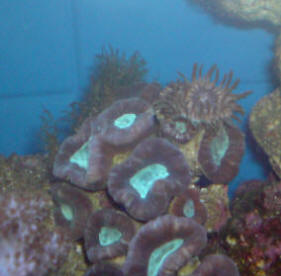
|
|
Invertebrate Identification 12/29/08
Greetings:
<Good Afternoon, Jessy here today>
I was fortunate enough last evening to observe a green creature
emerge from the live rock last evening, image attached. After
reading various descriptions on your excellent web site, it
appear that this could be a, harmless, Chiton? I apologize for
the lack of image quality. Do I recall correctly that these
consume coralline algae?
<You are right in your ID. It is in fact a Chiton. Harmless
algae grazer and a fun find. I, myself, just found one last week
and had to do the same ID search. Cheers, Jessy>
Bob Wright
|
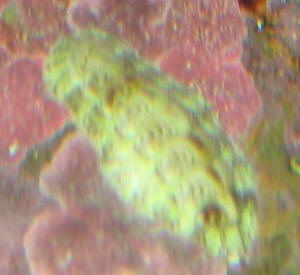 |
|
What Do You Think? (Cucumber ID/Husbandry)
11/11/08 Hi again crew and continued thanks for the
great site that I visit time and time again, you're help and
advice is second to none. <<Hi Simon, you're quite
welcome and thank you for the kind words>> I was wondering
if you can identify the cucumber in this pic? <<Mmm,
yes'¦ Looks to be a Colochirus species>> It is in
my LFS and I'm tempted to purchase it but thought I'd see
what you guys here can tell me about it. <<Start here and
read through the associated links
(http://www.wetwebmedia.com/seacukes1.htm), do also try a NET
search on the genus name>> It's marked up as candy
cucumber but the owner didn't know too much about it. Ii know
there can be a problem about the toxins released if cucumbers get
caught in pumps or are attacked, but was thinking of putting it
in my nano, what do you think? <<Hmm, this is one of the
safer Holothurids re toxicity/tank poisoning. But as a filter
feeder, it is also one of the more difficult species to feed
adequately. I have kept this species before, and have even had
them reproduce. But as stated, ensuring adequate feeding is/was
always an issue. That said, a single specimen in a small tank
where it is easily target-fed with suitably sized food stuffs
(thawed frozen foods like Cyclops-Eeze, Rotifers, Cyclops, Reef
Plankton, Oyster Eggs, etc.) may do well>> Also can you let
me know about feeding these as they seem to have feathery feelers
or tentacles? <<Yes'¦ Are filter feeders as just
explained>> One last thing, do you know what the anemone is
amongst these candy cane corals. <<Mmm, not
specifically'¦ Is perhaps a Majano'¦ Can be
nasty little buggers, see here
(http://www.wetwebmedia.com/anemoniafaqs.htm)>> I have them
spreading in my main tank are they nuisance and should I get rid
of them? <<Can be trouble for sure. I would take steps to
eradicate now>> Many thanks once again. <<Always
welcome>> Kind regards, Simon
<<Cheers mate. EricR>>
|
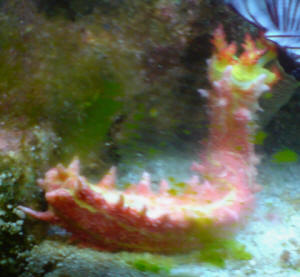
 |
|
Re: What Do You Think? (Cucumber
ID/Husbandry) 11/12/08 Cheers Eric that was a super fast
resend. <<Hiya Simon>> I was going to put the
cucumber in the nano I have, would it get sufficient food from
the other fish being fed or would you still recommend the direct
approach, would you turn off the flow in there whilst feeding
too? <<I would still target feed this animal. As for
turning off the water flow; only if it is so strong/directed such
that it interferes with the animals ability to capture the
food>> I like the fact of them reproducing how cool is
that, can they reproduce on their own (asexual)?
<<Indeed>> Also with the anemone problem, there was
only one and now three, this is in the matter of about two weeks.
<<Not uncommon>> I can't control them with pygmy
angels as it would be totally unfair due to the tank size,
<<Agreed>> I don't fancy the boiled water idea as
they are right on the bottom and this would mean a full tank
strip down. <<'¦?>> What about Joe's
juice or Aiptasia killing fluids, any you recommend. <<Have
used most all; the absolute best for Aiptasia eradication that
I've discovered thus far is Aiptasia-X from Red Sea. I
don't know how effective it will be against Majanos, but it
is certainly worth the try>> One very last thing (promise),
I have in my nano at the moment a little yellow rock goby,
vermiculate wrasse, tobacco basslet, gold cheek blenny? (I think
that's what they are called) and another goby long and
slender with brown body with yellow stripes (not sure on name).
<<Mmm, the wrasse (Macropharyngodon bipartitus) is a
difficult species that requires more real estate than this 90L
(23g) tank provides, as does the Tobacco Basslet>> Would
you recommend putting any of these fish in my main tank
(400litres) due to out-growing the nano (90litres)?
<<Yes'¦ The Vermiculate Wrasse and the Tobacco
Basslet>> Thing is I'll be getting triggers soon,
hopefully pair of blue throats. <<Wonderful fish (had a
pair myself once), and shouldn't be an issue re the Wrasse
and Basslet>> Many thanks again Si :) <<A pleasure to
share. Eric Russell>>
Re: What Do You Think? (Cucumber ID/Husbandry) -
11/12/08 Hi again, <<Hey Simon>> Found the
cucumber ID, it is Colochirus crassus. <<Ah
yes'¦>> Don't know if it has a common name
unless it's just pink cucumber. <<Or "Pink and
Yellow" Cucumber [grin]>> Cheers again guys. Si
<<Thanks for the follow-up mate! EricR>>
|
|
I.D. Please well actually two.... 11/10/08
Hello to whom ever is answering. <Hi Rain, Sara M. here with
you tonight.> First off I would like to thank all of you for a
god send of a site. <More like a God Emperor... our very own
Lord Leto, Mr. Fenner... and we his Fish Speakers. Sorry... have
been reading the Dune series all evening.> Ever since the
boyfriend decided to gift me with a 150gallon aquarium (and only
one small marine book, ugh like that helps), I have found your
site an invaluable source of information. <cool!> My tank
is 6 months old and the biggest fights we have is about stocking.
He wants to add and add and I say slow down. Oh sorry, side
tracked. So, to the id's. Attached is a picture of two pieces
of rock that have weird growth on them. The first one is a green
blob (which is on the left), and the second is a brown leathery
thing with two openings which retract when touched. I was
thinking after reading your site on sea squirts that it is in
fact a sea squirt. Sorry that the picture is not crystal clear. I
had to resort to use my phone camera because the proper camera
somehow wound up in the tank......... A whole other fight.. Well
I am going to say thank you very much before I ramble. <The
thing in the center of the photo does indeed look like a sea
squirt. Unfortunately, I can't make out the other
thing, the "green blob" (on the left)-- it might be
bubble algae or perhaps a majano anemone? I can't tell from
this photo... sorry.> Sincerely, and thanks Rain
<Great name, Rain, and de nada,
Sara M.>
|
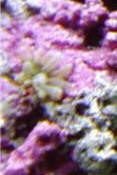
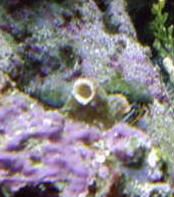 <Not sure about the left, but the right is a
Sea Squirt -Sara M.> <Not sure about the left, but the right is a
Sea Squirt -Sara M.> |
|
Hitchhiker bivalve 11/8/08 Hello there! I
hope you're having a great weekend! <Thanks Gareth, yep,
it looks to be a terrific weekend!> For a while now I've
been trying to find an identification for a hitchhiker that
I've had on my live rock since my tank was set up in June
last year. <Neat> I would very much like to get a positive
identification purely because I'm curious to find out more
about it. I've searched here and on the 'net to no avail,
could you please tell me what it is? <I sure wish I could, but
I can't see quite enough detail to narrow it down
sufficiently. Don't get me wrong, you got a great photo,
especially given the fact that these guys never seem to arrange
themselves with our viewing pleasure in mind! What I would need
are at least two good hi-res photos: one taken from directly
above (in order to see the entire shape of the shell and see
where it's hinged) and one from the side (same goes). I'd
also need to know the size and where it hitchhiked in from.
Locale can make all the difference when it comes to ID work. All
is not lost though. I've got a site for you to peruse
that's one of my favorites. It may well enable you to narrow
things down to family or even genus level. Considering the number
of bivalve families and genera out there, that's quite an
accomplishment! At the following site, please see the category
�Bivalves� and select/go
through the various shapes shown. Each shape will take you a page
with photos, and each photo is a link to more photos and
information.
http://shell.kwansei.ac.jp/~shell/pic_book/shape.html - Hope that
helps!> Thanks you very much for your time! Kind regards,
<It was my pleasure, Gareth.> Gareth <Take care and have
a great weekend! -Lynn>
|
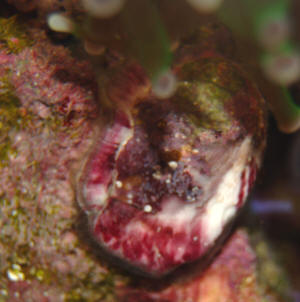 |
|
Coral or Anenome Identification
11/07/08 Hello Crew! First, a requisite thanks for the
incredible service you provide the aquarium hobby with! <our
pleasure/passion> I've recently noticed an interesting
creature in my tank that only appears at night. During the day
time, it's almost impossible to see that it actually exists -
it seems to shrink up into a tiny little ball. At night-time, it
expands to about an inch in diameter. I've noticed as well,
that it has split/multiplied at least once in the past few
months, as there appears to be another identical creature
sprouting up next to it. At first I thought it was an
aiptasia/majano, but the pictures shows these little balls at the
tips of the arms, it also has no extended base, as is typical
with aiptasia. As well, there is no green colouring. <This
doesn't necessarily preclude it from being a majano
anemone...> Anyways - I have not noticed any
"aggressive" behaviour from it. It has been growing
steadily over the past few months however - I've been
tracking growth based on the fact that it appears to have more
tentacles than the last time I checked, and its diameter has been
increasing steadily as well. What on earth is it?! I've heard
of "reverse-photosynthetic" creatures, which thrive in
the darkness. This creature clearly does not like the light, is
in a very, very shaded area, and only expands during the night!
Neat! I can't believe I was able to get such crisp pictures
as well. <I *suspect* that this is an anemone. However, in
order to be sure, you'll have to see if you can find a
skeletal base. When it's retracted, feel beneath if for a
skeleton. If no skeleton, then I'd say it's most likely
an anemone.> Hope you can help me out! I've included two
pictures. --Adam
Sara M.>
|
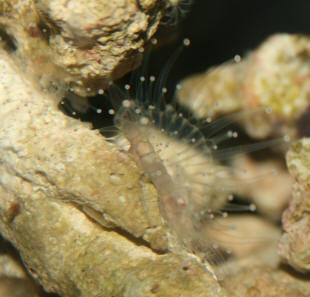 |
|
|

